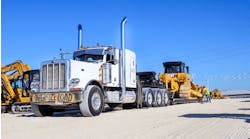Rock Transfer and Storage (RTS) of Milwau-kee, WI, really racks up the miles on its 73-vehicle leased fleet, picking up and delivering freight throughout the Midwest and as far away as the East Coast and back. As a local and regional LTL carrier, RTS appreciates the value of good fuel economy. Every measure it can take to cut costs is important.
Terry Hogan, vp-operations for RTS, says to keep fuel consumption under control takes a combination of good aerodynamic trucks and drivers who are properly educated in operating them for maximum fuel efficiency. RTS, he notes, currently leases 68 Peterbilt tractors from PacLease. About half of them are sleeper trucks for the company's over-the-road operations, the other half daycabs. “Our road trucks average 2,900 mi. a week, while the daycabs do about 250 mi. a day,” he reports.
“A few years ago we made a concerted effort with our [84] drivers to stress the importance of fuel economy. We made them aware they were going to be playing a vital role in helping us control, and hopefully increase, fuel mileage by doing things like using cruise control, reducing idling time, and minimizing sudden stops. Our director of safety and compliance, Vic Boor, conducts orientation programs for new drivers and that's one of the main points he emphasizes,” Hogan says.
“We download ECM information from each truck and monitor driver performance in a number of key areas on a regular basis,” Boor says. He notes the carrier also recently converted its OTR fleet from Peterbilt 379 models to the more aerodynamic 387 models, which are spec'd with automatic transmissions that allow for progressive shifting. “We've realized about a one to one-and-one-half miles-per-gallon increase in fuel economy as a result.
“Other things we've done is to begin installing Thermo King's TriPac auxiliary power units for drivers so they are able to heat or cool their bunks without idling the engine,” he adds. “Besides fuel economy, we spec our trucks for driver retention, such as with all premium interiors.” Drivers average 8½ to 10 years with the company.
The majority of customers for RTS are in the foundry and automotive-related industries. Some of the company's largest clients include Cummins engine, Allison transmissions, GE Transportation and Oshkosh Trucks. Terry Hogan explains that in the local LTL operation, drivers average 12 to 15 pickups and deliveries a day of parts and suppliers (as well as finished products) for either same- or next-day service.
The road fleet, on the other hand, averages 18 to 20 pickups a week, traveling from one of RTS's two facilities in Milwaukee or Toledo, OH, to anywhere as far west as Minnesota, to the East Coast and down to Virginia. “Our drivers' main function is to drive,” says Hogan. “We don't want them touching freight, so the majority of stops are dock to dock with 90 to 95% of freight being palletized.”
The Rock Transfer trailer fleet, Boor states, numbers 110 units ranging in size from 45 to 53 ft. They are 100% dry vans, mostly Great Danes and Stoughtons, and all company owned, although he notes that PacLease does provide maintenance for the trailer fleet as well as the leased tractors since RTS does not have its own servicing capabilities.
According to Hogan, the primary reason RTS chooses to lease its tractors is the savings in cash outlay that it can use for other things like purchasing trailers. Leasing also allows the carrier to rotate equipment more frequently without having to worry about selling off older units themselves. And, Boor adds, PacLease's extensive, nationwide network alleviates maintenance headaches and having to find someone to respond to breakdowns while the trucks are away from home.
“One of our biggest challenges as an LTL pickup and delivery fleet is satisfying customers' increasing demands for just in time service,” says Hogan.
PacLease has helped by guaranteeing them, in the case of a breakdown, that if their own truck is not up and running within a two-hour window, a substitute vehicle will be provided. Hogan sums it up best when he says, “It's a competitive industry, and you have to do everything you can to stay one step ahead or you will get swallowed up.”


